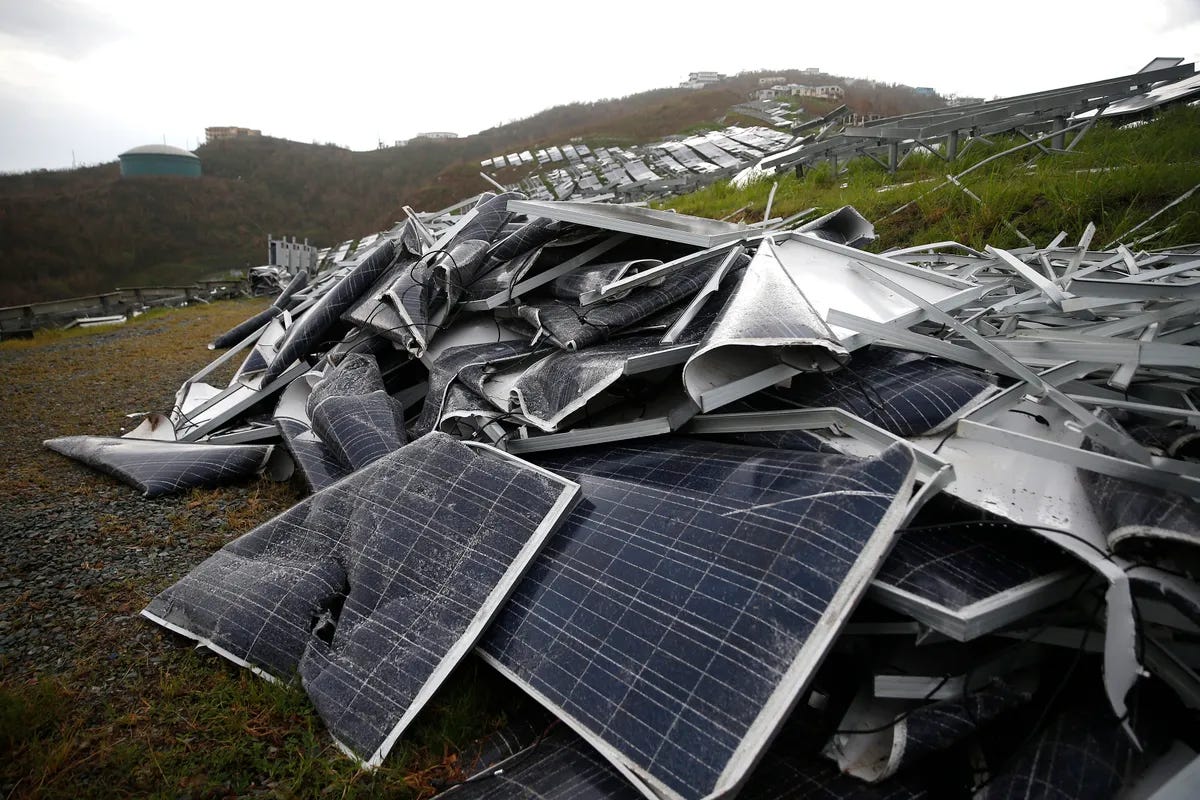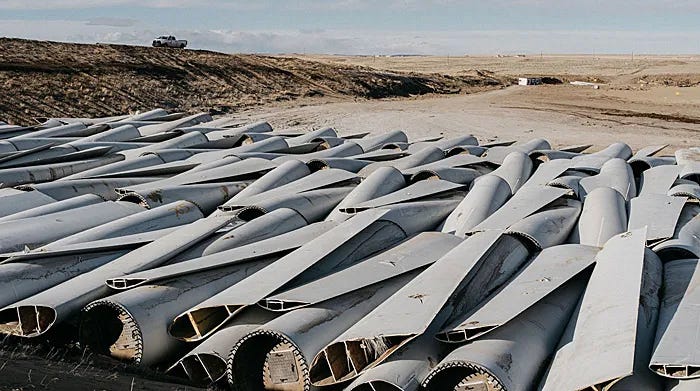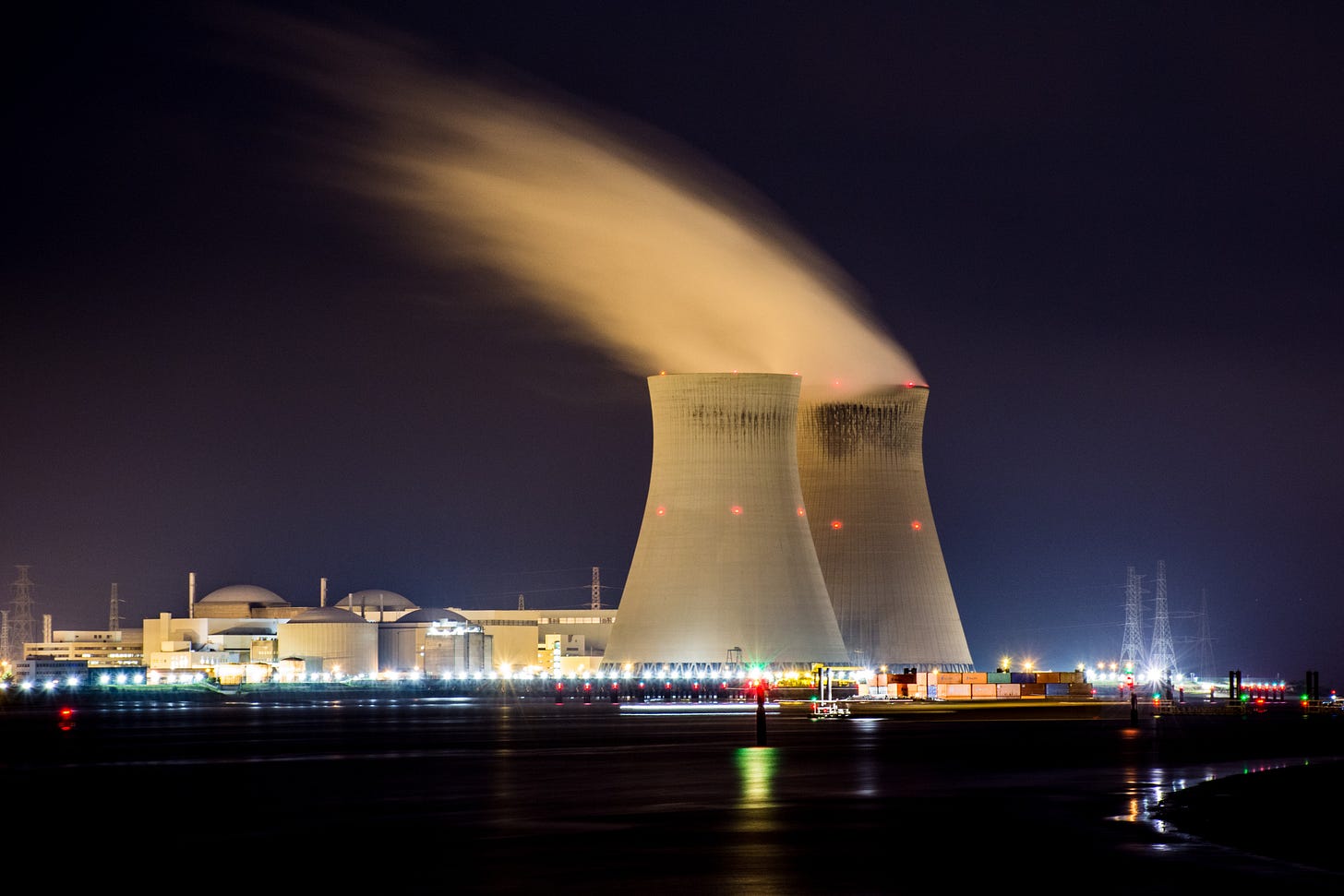If environmentalists really cared about clean energy...
They'd ditch the legacy technologies and adopt the clear winner - nuclear
Introduction
Environmentalists have promoted wind and solar as the beacons of hope to save the planet – but is it actually working? Are there cleaner, more effective solutions out there?
I worked in the solar energy industry for years, so I have first-hand knowledge of the pros and cons in the space. I was at a startup company that rapidly accelerated and although I learned a lot during this time, it felt like a cult at times. Colleagues were singularly focused on solar, and solar alone, being the major factor in saving the planet but every time I brought up nuclear or the downsides of solar it was dismissed.
Germany, once the proud example of reducing the reliance on coal, has turned back on that promise as renewables have not been able to fulfill demand. Now Russia is threatening Europe’s access to heating and gas. Recently the UN and World Bank have been pouring money into nations like Kenya to expedite adoption of wind, solar, and hydro.
There are cheaper, more effective, and safer alternatives to the usual duo of wind and solar: enter nuclear power. “Solar farms take 450 times more land than nuclear plants, and wind farms take 700 times more land than natural gas wells, to produce the same amount of energy.” (2). Modern versions of nuclear technology make it incredibly safe as well.
The traditional renewables have been propped up by extensive government subsidies – in anything resembling a free market, these technologies would soon have been replaced by nuclear and/or other (perhaps yet unknown) technologies. Yet government picks and chooses winners (not just in energy creation, of course) and it has clearly propped up a loser. The energy sector is filled with cult-like behavior that has a myopic view on ‘their’ technology winning.
Germany – once the leader in traditional renewables, is backtracking
As referenced above, Germany is no longer phasing out coal but is bringing it back in order to supplement energy demands.
In the 1970s Germany was pro-nuclear in the face of instability in the oil markets, but still faced some pushback which inevitably increased with the Chernobyl disaster in 1986. No new reactors had been built in Germany since 1989. After the Fukishima event in 2011, German officials announced that all nuclear reactors be shut down by 2022. “In 2002, nuclear power constituted 30.9 percent of German commercial energy generation. In 2020, it’s down to 11.9 percent.” (1)
During this same time, solar/wind/hydro has grown year after year, yet Germans are paying record high prices for energy and public sentiment seems to support paying higher prices to avoid nuclear at all costs – it’s a case of ignorance and big government policies ruining a perfect opportunity to transition to actually clean power.
“According to a 2015 survey produced by the Emnid, a polling institute for the German outlet BILD am Sonntag, 81 percent of Germans believe that it is the right decision to phase-out nuclear power, and only 16 percent think that it is wrong. This becomes even clearer when looking at those 14 to 29 years old—93 percent of this group support the transition.” (1)
Other polls show that public support for these policies is failing though. As Michael Shellenberger wrote, “Over the past five years alone, the Energiewende [Germany’s centrally-planned effort to transition to ‘green’ energy] has cost Germany €32 billion ($36 billion) annually, and opposition to renewables is growing in the German countryside.” (2). As with most government initiatives the juice isn’t worth the squeeze – the cost goes to inferior technology and much of costs are dedicated to bureaucracies and committees. And despite all of these efforts, “Its emissions have flat-lined since 2009” (2).
Shellenberger also notes that “Germany was forced to acknowledge that it had to delay its phase-out of coal, and would not meet its 2020 greenhouse gas reduction commitments. It announced plans to bulldoze an ancient church and forest in order to get at the coal underneath it.” (2). Now with the Nord Stream 2 gas pipeline in jeopardy, I wonder what the bureaucrats in Germany will do – shift to nuclear, revert back to coal, or double down on the traditional renewables?
Solar - an inefficient and hideous solution
As mentioned above I worked in at a startup company in the solar industry. During this time I ran the logistics and distribution operation for the US-based operations. Let me start off by stating that warehousing and transporting solar panels is a major pain. Freight carriers constantly broke panels, as did the warehouses when doing pick and pack operations. Many forklifts don’t have long enough forks and when they attempt to lift a pallet of panels, the forks would gouge/break the bottom panels. I can’t say how many damaged freight claims I’ve made…
On a macro scale, compared to nuclear, solar is inefficient and costs much more to handle the waste and by-products. They’re also ugly and take up a lot of space. I referenced it above but it bears repeating, “Solar farms take 450 times more land than nuclear plants” to produce the same amount of energy (2).
There are also excessive procurement lead times because much of the supply is still coming from China. This was another fact I frequently brought up with colleagues – mainly because these people apparently care about the environment, but never wonder why Chinese accounts for so much supply. The process of creating solar panels is incredibly toxic and resource-intensive.
Not only that, but discarded panels are a serious threat as well. “A new study by Environmental Progress (EP) warns that toxic waste from used solar panels now poses a global environmental threat. The Berkeley-based group found that solar panels create 300 times more toxic waste per unit of energy than nuclear power plants. Discarded solar panels, which contain dangerous elements such as lead, chromium, and cadmium, are piling up around the world, and there’s been little done to mitigate their potential danger to the environment.” (4). It’s also often cheaper to dump them in landfills or send them to developing countries – in fact estimates report that it costs 10 to 30 times more to recycle than to send panels to a landfill. “As solar panels sit in dumps, the toxic metals they contain can leach out into the environment and possibly pose a public health hazard if they get into the groundwater supply.” (5).
The cult-like behavior has also been blinded to the fact that degradation happens much faster than reported. It’s been commonly believed that a given panel will last 25 years in normal conditions. “But new research finds that solar panels in use degrade twice as fast as the industry claimed. And that report came on the heels of a separate report which found that solar panels have been suffering a rising failure rate even before entering service. “One in three manufacturers experienced safety failures relating to junction box defects, an increase from one in five last year,” noted an industry reporter. The “majority of failures were prior to testing, straight from the box.” (5).
“It’s now clear that China made solar appear cheap with coal, subsidies, and forced labor. And in the U.S., we pay one-quarter of solar’s costs through taxes and often much more in subsidies at the state and local level.” (5). Not only does China used forced labor camps to keep costs down, but the lax environmental regulations allow them to dump toxic by-products directly into the earth and into streams. Many in the environmental space lean progressive, which one would think converges with human rights – yet these same people are mostly oblivious to these violations of basic human rights and the environment.
Wind - even uglier than solar, and also a recycling nightmare
Growing up in California and traveling in my RV for months across the western US, I’ve seen my share of wind turbine farms. And every time I see them I can’t help but think how downright ugly they are. Not only that, they ruin the natural landscape in many beautiful areas of the country but they’re not efficient, kill birds, and also have issues with end-of-life disposal. It’s another example of the State picking winners which are really losers. Government subsidies have kept this industry afloat, not the free market.
Compared to nuclear, “To match the energy output of a single modern reactor, it would take approximately 400 miles of the most modern wind turbines” (6). Think of all the other uses for 400 miles of land, and extrapolate that to every part of the world which uses this inefficient technology that blots the natural landscape everywhere they are. The world has a lot of land dedicated to wind energy.
Similar to solar panels, what happens to the turbines and other equipment when it reaches end-of-life? Many greenies don’t consider this. But “barring a major increase in processing capability, experts expect that more than 720,000 tons worth of gargantuan wind turbine blades will end up in U.S. landfills over the next 20 years. ” (5). The evangelists get so caught up in ‘saving the environment’ in the current year but don’t plan for the future at all, despite their so-called attempts to save the planet for future generations.
Many developing countries are adopting wind farms as well, of course bankrolled by wealthier western nations. “The new wind farm in Kenya, inspired and financed by Germany and other well-meaning Western nations, is located on a major flight path of migratory birds. Scientists say it will kill hundreds of endangered eagles.” (2). All over the world birds are being killed by these wind turbines. “Joel Merriman, a wind specialist at charity the American Bird Conservancy, modelled the death rate at the start of 2021. He accounted for the fact that many of the bird death studies were published earlier in the decade and the numbers will have increased since then. He also factored in that many deaths of smaller birds will escape the notice of studies. Merriman concludes that 1.17 million birds are killed by wind turbines in the US each year.” (7).
1.17 million birds killed each year, just in the US! Again, this just points out the incredibly myopic view that environmentalists have – that so-called ‘climate change’ is the only thing to focus on (or wait, was it global warming?). On a side note, it reminds me of the recent virus hysteria while ignoring all of the by-products of locking people down, with kids unable to understand facial expressions due to masking, missed cancer screenings, and other related consequences – all to apparently stop a virus with a damn near 100% IFR. But I digress…
Back to Kenya, Schellenberger accurately points out “Kenya won't be able to “leapfrog” fossil fuels with its wind farm. On the contrary, all of that unreliable wind energy is likely to increase the price of electricity and make Kenya’s slow climb out of poverty even slower.” (2). Not only is it at risk of killing hundreds of endangered eagles, but it’s further impoverishing Kenyans.
Wind is another State-sponsored failure. The free market wouldn’t allow such a technology to survive for this long. It’s a tech that kills millions of birds each year, is inefficient, ruins natural landscape skylines, and should be relegated to the history books.
Enter nuclear power - the cleaner solution to green energy
Before everyone jumps on the Chernobyl incident, let’s clear that up. Chernobyl was due to bad engineering, denial of the problem, and lack of accountability. It’s the hallmark of a state-run project.
Now, with that out of the way let’s focus on why it’s a clear winner in the race for clean energy. It’s cheaper, cleaner, safer, and more efficient.
Nuclear power is the safest source of energy: safer than fossil fuels, and safer than all other types of renewable energy sources (6).
In this published article in ScienceDirect, the authors emphatically state that “...in the long term, we argue that nuclear fission technology is the only developed energy source that is capable of delivering the enormous quantities of energy that will be needed to run modern industrial societies safely, economically, reliably and in a sustainable way, both environmentally and as regards the available resource base. Consequently, nuclear fission has to play a major role in this necessary transformation of the 21st century energy-supply system.” (9). The authors state that a mix of technologies will be needed but that nuclear is clearly the ‘best’ option and should be a major part of any clean energy solution.
Regarding nuclear waste, there are drawbacks here as well just like with the other technologies referenced earlier. In this article by ACSH, “The best option, in our opinion, is to utilize the Yucca Mountain storage facility.” They continue in the article to reference a different proposed solution: “The Breakthrough Institute proposes a different solution. It argues that Yucca -- or any single, centralized location -- is not a good solution because the amount of waste we have generated is quite substantial. Yucca would need to be expanded. Instead, the report suggests that we formalize what we've been doing; that is, make decentralized, on-site storage at nuclear power plants in cooling pools and dry casks the official policy. These sites could also be supplemented with regional consolidated storage facilities.” (10).
There’s also a fungi discovered a few years ago that can help clean up any radioactive waste (11).
People still have unfounded fears of nuclear based on a few examples spanning decades, but modern technology in the nuclear industry, especially compared to other ‘green solutions’, make it clear that nuclear is what we need to adopt on a global scale. In the above sections I outlined why solar and wind are inferior to nuclear, and I think the case is clear. Allow a free market to adopt the best tech, which I believe is nuclear. Stop the government favoritism and related subsidies for the other technologies immediately.
It's time to embrace the truth: Nuclear is the best, carbon-free source of energy we have. (8)
References
https://fee.org/articles/why-is-germany-phasing-out-nuclear-power/
https://www.nationalreview.com/2017/06/solar-panel-waste-environmental-threat-clean-energy/
https://uhighmidway.com/7344/opinion/nuclear-energy-is-our-best-option/
https://www.sciencedirect.com/science/article/pii/S2214993714000050
https://envirobites.org/2018/02/09/fungi-to-the-rescue-can-fungi-help-clean-up-radioactive-waste/








